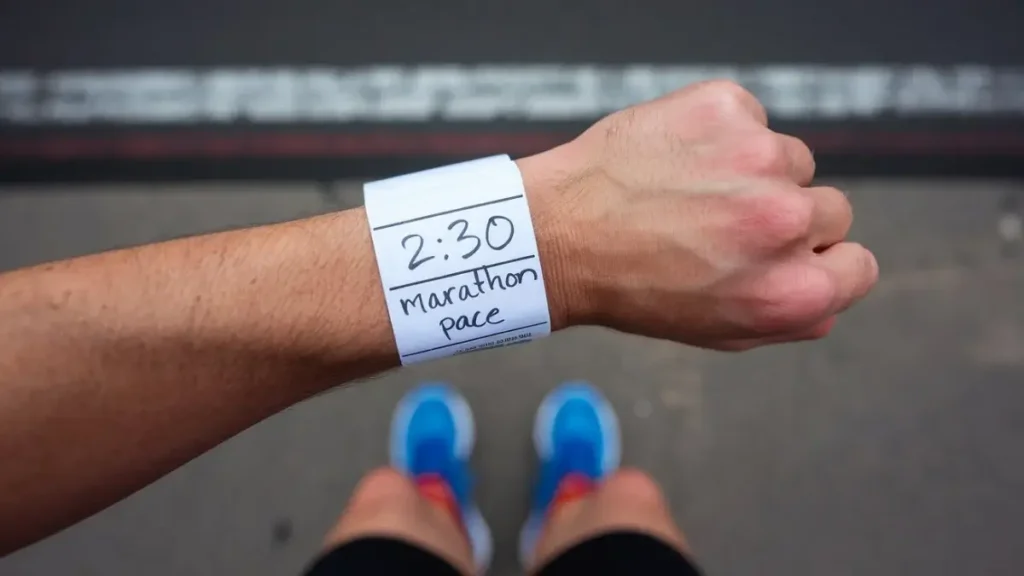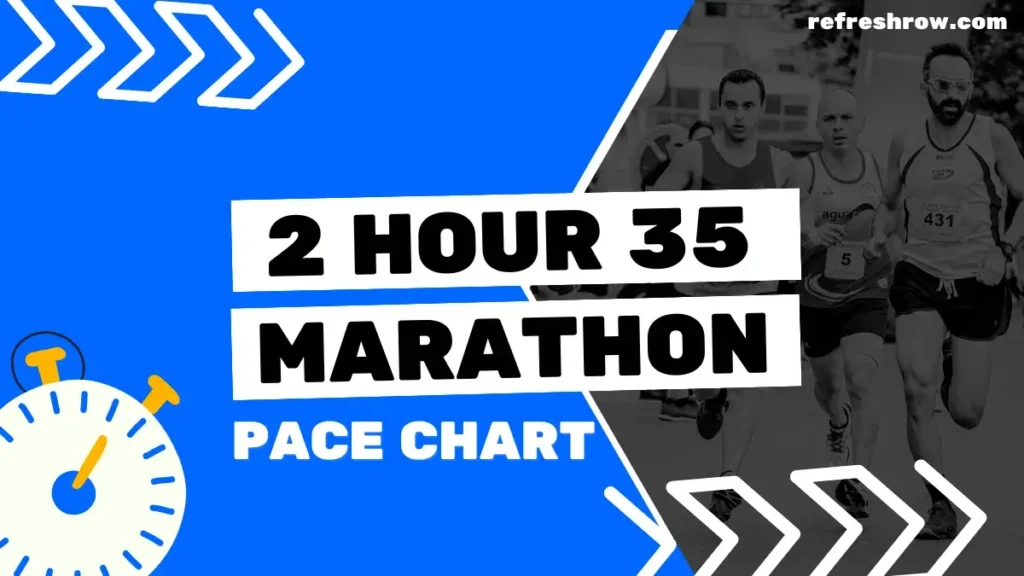To run a 4:20 hour marathon you need to run at a pace of 9:55 per mile or 6:10 per kilometer.
Following the splits below (and shaving off a second), you’ll run a sub 4:20 marathon.
I’d recommend aiming to run 1-2 minutes ahead of the split target time from 10 miles, as you’ll likely come up against crowding on race day.
4:20 Marathon Pace in Miles
| Mile | Split |
|---|---|
| 1 | 9:55 |
| 2 | 19:50 |
| 3 | 29:45 |
| 4 | 39:40 |
| 5 | 49:35 |
| 6 | 59:30 |
| 7 | 1:09:25 |
| 8 | 1:19:20 |
| 9 | 1:29:15 |
| 10 | 1:39:10 |
| 11 | 1:49:05 |
| 12 | 1:59:00 |
| 13 | 2:08:55 |
| 14 | 2:18:50 |
| 15 | 2:28:45 |
| 16 | 2:38:40 |
| 17 | 2:48:35 |
| 18 | 2:58:30 |
| 19 | 3:08:25 |
| 20 | 3:18:20 |
| 21 | 3:28:15 |
| 22 | 3:38:10 |
| 23 | 3:48:05 |
| 24 | 3:58:00 |
| 25 | 4:07:55 |
| 26 | 4:17:50 |
| 26.2 | 4:20:00 |
4:20 Marathon Pace in KM
| KM | Split |
|---|---|
| 1 | 6:10 |
| 2 | 12:19 |
| 3 | 18:29 |
| 4 | 24:39 |
| 5 | 30:49 |
| 6 | 36:58 |
| 7 | 43:08 |
| 8 | 49:18 |
| 9 | 55:27 |
| 10 | 1:01:37 |
| 11 | 1:07:47 |
| 12 | 1:13:57 |
| 13 | 1:20:06 |
| 14 | 1:26:16 |
| 15 | 1:32:26 |
| 16 | 1:38:35 |
| 17 | 1:44:45 |
| 18 | 1:50:55 |
| 19 | 1:57:05 |
| 20 | 2:03:14 |
| 21 | 2:09:24 |
| 22 | 2:15:34 |
| 23 | 2:21:43 |
| 24 | 2:27:53 |
| 25 | 2:34:03 |
| 26 | 2:40:13 |
| 27 | 2:46:22 |
| 28 | 2:52:32 |
| 29 | 2:58:42 |
| 30 | 3:04:51 |
| 31 | 3:11:01 |
| 32 | 3:17:11 |
| 33 | 3:23:20 |
| 34 | 3:29:30 |
| 35 | 3:35:40 |
| 36 | 3:41:50 |
| 37 | 3:47:59 |
| 38 | 3:54:09 |
| 39 | 4:00:19 |
| 40 | 4:06:28 |
| 41 | 4:12:38 |
| 42 | 4:18:48 |
| 42.2 | 4:20:00 |
Other Marathon Pace Charts
Targeting a different time?
Check out the Full Marathon Pace Chart in Miles or KM
Or select a specific finishing time below:
| 3:00 | 4:00 | 5:00 | |
| 3:05 | 4:05 | 5:15 | |
| 3:10 | 4:10 | 5:30 | |
| 3:15 | 4:15 | 5:45 | |
| 3:20 | 4:20 | 6:00 | |
| 3:25 | 4:25 | 6:15 | |
| 2:30 | 3:30 | 4:30 | 6:30 |
| 2:35 | 3:35 | 4:35 | 6:45 |
| 2:40 | 3:40 | 4:40 | 7:00 |
| 2:45 | 3:45 | 4:45 | |
| 2:50 | 3:50 | 4:50 | |
| 2:55 | 3:55 | 4:55 |
Training for a 4:20 Marathon
Is 4:20 a Good Marathon Time?
Well, what do the stats say?
Run Repeat conducted a study that contains 19,614,975 marathon results from more than 32,335 races across the globe, here is how a 4:20 marathon compares against age and gender for the races recorded:
| Overall | You’re faster than 55.8% of all runners. |
| Male | You’re faster than 44.9% of males. |
| Female | You’re faster than 70.3% of females. |
| <20 | You’re faster than 53.7% of under 20s. |
| 20-29 | You’re faster than 49.1% of 20-29 year olds. |
| 30-39 | You’re faster than 48.6% of 30-39 year olds. |
| 40-49 | You’re faster than 53.0% of 40-49 year olds. |
| 50-59 | You’re faster than 65.6% of 50-59 year olds. |
| >60 | You’re faster than 82.9% of over 60s. |
Training Runs and Paces for a 4:20 Marathon
To break a 4:20 marathon you’ll need to do some serious distance in your training, I recommend at least 15 miles (24km) per week.
You’re also going to need to make sure you’ve crossed off these milestones for other race distances:
- A 5k in 27:05 mins
- A 10k in 56:40 mins
- A half marathon in 2 hours
Training Paces
| Pace | Mins per Mile | Mins per KM |
|---|---|---|
| Easy | 11:10 | 6:56 |
| Steady | 9:55 | 6:09 |
| 10k | 9:05 | 5:39 |
| 5k | 8:43 | 5:25 |
| 1 Mile | 8:06 | 5:03 |
Weekly Mileage Targets
| Target Mileage: | Gradually increase your weekly mileage from 25 miles (40km) to a peak of 36 miles (58 km). |
| Incremental Increase: | Increase mileage by approximately 10% each week, with every fourth week as a recovery week where mileage is reduced by 20-30%. Make sure to taper for the last 1-2 weeks. |
Long Run Structure
| Total Distance: | Build up to long runs of 20-22 miles (32-35 km). |
| Segment Example: | First 5 miles (8 km): Easy pace, heart rate 140-150 bpm (approximately 11:45/mile or 7:18/km). Next 1 mile (1.6 km): Fast pace at 8:30/mile (5:17/km). Next 5 miles (8 km): Medium effort, heart rate around 160 bpm (approximately 9:30/mile or 5:54/km). Repeat: Repeat the segment twice (5 miles easy, 1 mile fast, 5 miles medium), you can taper the final 2 miles if required. |
Why This Works: Incorporating varied paces within long runs enhances lactate tolerance, which helps on race day when you’ve got to maintain pace despite feeling fatigued. By practicing surges during a run, you can build up your physical and mental resilience (lots of elite marathon runners use these strategies during their training)
Alternating Long Runs: Alternate between structured long runs (easy/fast segments) and easier long runs. For easier long runs, maintain a steady, comfortable pace throughout, focusing on mileage rather than speed to aid recovery.
Speedwork Sessions
| Short Intervals: | – 800m repeats at 4:10 per interval (5:10/km). – Aim for 6-8 repetitions with equal time for recovery. |
| Mile Repeats: | – 1 mile repeats at 8:30 per mile (5:17/km). – Aim for 5-6 repetitions with a 1-2 minute recovery jog. |
| Longer Intervals: | – 2 mile repeats at 8:40 per mile (5:24/km). – Aim for 3-5 repetitions with a 2-3 minute recovery jog. |
Recovery and Rest Days
| Rest Days: | You don’t need to incorporate rest days if you are using recovery runs, but I recommend taking 1 (or a max of 2) per week to allow your body to recover and prevent overtraining. |
| Easy Run Days: | Include 1-2 easy run days per week at a relaxed pace of 12:00/mile (7:27/km), covering 5-10 miles (8-16 km) per day. Try to keep your heart rate below 140 bpm on easy days to ensure proper recovery and aerobic development. |
My Tips to Run a Sub 4:20 Marathon
Optimize Your Running Form
Running efficiency becomes increasingly important as the miles add up in a marathon.
Small improvements in your running form can translate into significant energy savings over the mammoth 26.2 miles.
Pay attention to your posture – keep your shoulders relaxed, and as you tire it’s really important to try and avoid slouching (I know this is easier said than done).
During your training have a practice at trying to land softly on your midfoot to reduce impact and maintain a quick, light cadence to improve your efficiency.
Incorporate form drills into your warm-ups, like high knees and butt kicks (this will help to reinforce good habits).
These small tweaks can have a major impact and help you maintain pace more comfortably throughout the marathon.
Prioritize Recovery to Stay Consistent
One of the favorite phrases is “Consistency Compounds” – and that never rings more true when prioritizing recovery just as much as your runs.
Proper recovery = more running.
Make sure you’re incorporating proper cooldowns, stretching, and try introducing a foam rolling (to see if it works for you) to keep your muscles loose and prevent injuries.
Consider adding yoga or gentle stretching sessions a couple of times a week to improve your flexibility.
As well as the basics (but probably the most important) Adequate sleep and good nutrition, they’re the foundation of recovery.
Taking care of your body will help you to maintain your training schedule and show up on race day feeling strong and prepared.
Hydration and Nutrition: The Small Gains Matter
Also, the small details, like hydration and nutrition, can make a big difference in your performance.
Develop a hydration and fueling plan during your long training runs that you can easily replicate on race day.
E.g. Aim to sip water or sports drinks regularly and consume energy gels or snacks at consistent intervals – every 45 minutes works well for many runners.
I personally have water every 20 minutes, and a gel with sports drink every 30 minutes.
This routine keeps your energy levels stable and helps prevent the late-race fatigue that can derail your pace.
(It can also help to pass the time as it breaks down the run).
Training your stomach to handle nutrition during runs is just as important as training your legs.
Find Joy in the Journey
Finally, a really important note:
Training should be challenging, but it should also be enjoyable.
Make sure to find joy in the process, whether it’s by running with a friend, exploring new routes, or rewarding yourself after tough long sunday runs.
The key is to keep your motivation high, even on days when getting out the door feels rough.
Celebrate the small victories along the way – each new distance record, each time you lace up your shoes when you didn’t feel like it.
This positive mindset will carry you through both your training and race day, making the entire experience more fulfilling.
And hopefully make you fall in love with running like me.


Row Brown is the founder of Refresh Row. He is a keen marathon runner, his favorite being the London Marathon. He’s now set himself the mission of Running the Entire Length of Spain, which is scheduled for late 2024.


